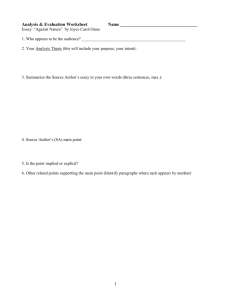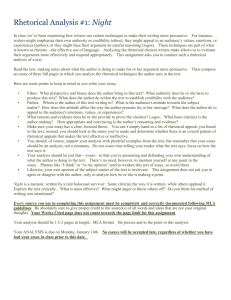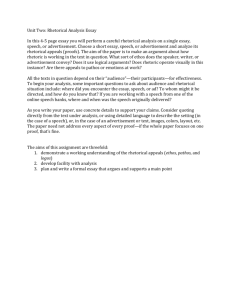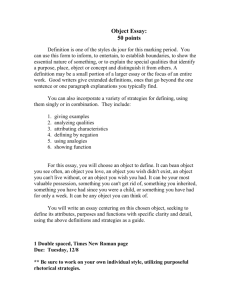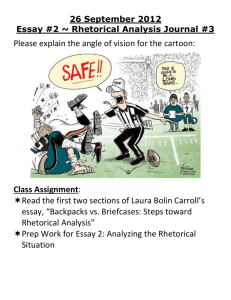Persuasive Essay Process
advertisement
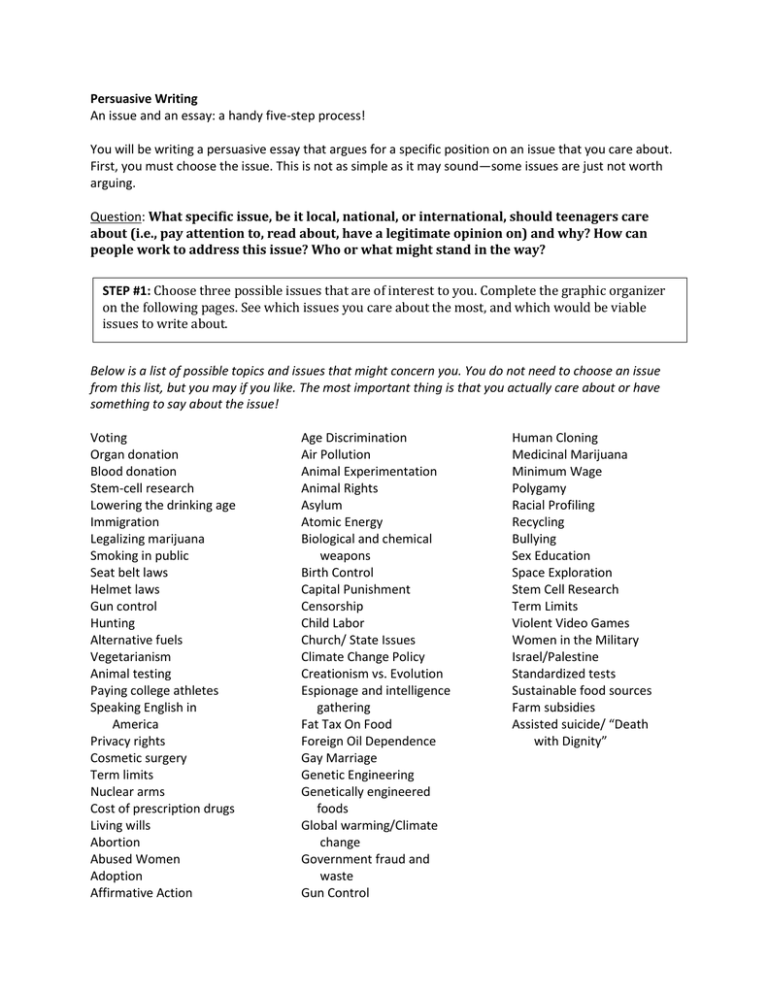
Persuasive Writing An issue and an essay: a handy five-step process! You will be writing a persuasive essay that argues for a specific position on an issue that you care about. First, you must choose the issue. This is not as simple as it may sound—some issues are just not worth arguing. Question: What specific issue, be it local, national, or international, should teenagers care about (i.e., pay attention to, read about, have a legitimate opinion on) and why? How can people work to address this issue? Who or what might stand in the way? STEP #1: Choose three possible issues that are of interest to you. Complete the graphic organizer on the following pages. See which issues you care about the most, and which would be viable issues to write about. Below is a list of possible topics and issues that might concern you. You do not need to choose an issue from this list, but you may if you like. The most important thing is that you actually care about or have something to say about the issue! Voting Organ donation Blood donation Stem-cell research Lowering the drinking age Immigration Legalizing marijuana Smoking in public Seat belt laws Helmet laws Gun control Hunting Alternative fuels Vegetarianism Animal testing Paying college athletes Speaking English in America Privacy rights Cosmetic surgery Term limits Nuclear arms Cost of prescription drugs Living wills Abortion Abused Women Adoption Affirmative Action Age Discrimination Air Pollution Animal Experimentation Animal Rights Asylum Atomic Energy Biological and chemical weapons Birth Control Capital Punishment Censorship Child Labor Church/ State Issues Climate Change Policy Creationism vs. Evolution Espionage and intelligence gathering Fat Tax On Food Foreign Oil Dependence Gay Marriage Genetic Engineering Genetically engineered foods Global warming/Climate change Government fraud and waste Gun Control Human Cloning Medicinal Marijuana Minimum Wage Polygamy Racial Profiling Recycling Bullying Sex Education Space Exploration Stem Cell Research Term Limits Violent Video Games Women in the Military Israel/Palestine Standardized tests Sustainable food sources Farm subsidies Assisted suicide/ “Death with Dignity” Topic 1: My view: Possible support: What should happen or change? Opposing view: Topic 2: My view: Possible support: What should happen or change? Opposing view: Topic 3: My view: Possible support: What should happen or change? Opposing view: STEP #2: Narrow down your choice to one issue (with a possible runner-up). Do some preliminary research on your issue of choice using the internet—what do others have to say? Can you find any reliable data relating to this issue? Have you found TOO MUCH reliable data to sort through? Decide on the issue you will write about and state your position (your POINT or CLAIM) below. ISSUE: _______________________________________________________________________________ POINT: ______________________________________________________________________________ STEP #3: Begin your research in the MHS library. You will be instructed (or refreshed) on how to access the online databases that contain tons of useful information on many issues. You will also be instructed on how to access the library catalog for print resources. You should TAKE NOTES that will support your point as well as notes that explain the opposition. Make sure you keep track of the sources you use and that you copy down facts, statistics, and quotes correctly. Printing articles or websites to ensure accuracy is recommended! For books, collect all of the publication data; photocopying the copyright page is helpful! For databases, use the source citations at the end of the articles. For general websites, record the URL, author, title of page, author, and date updated. Use www.easybib.com to create citations for books and websites; a complete bibliography is required for this essay! STEP #4: Begin writing by creating an outline. This is where you gather and organize your point, support, examples, opposition, and call to action in one place. This is an INFORMAL document meant to guide your writing. It should look like this: A Title for your Essay I. Topic statement (statement of opinion) in a complete sentence A. an interesting hook B. any other information you will use here—no specifics or statistics yet! II. First supporting reason (in a complete sentence) A. Explain B. Statistic or anecdote C. “If…then” statements D. Tie it back to your opinion III. Second supporting reason (in a complete sentence) A. Explain B. Statistic or anecdote C. Don’t forget the three appeals! D. Tie it back to your opinion IV. Third supporting reason (in a complete sentence) A. Explain B. Statistic or anecdote C. Don’t forget the three appeals! D. Tie it back to your opinion V. Address the opposition A. State the opposing position B. Provide a quote or statistics to clarify D. Disprove the opposition VI. Conclude by restating your opinion A. Prediction for the future if people don’t agree with you B. Call to action: command the audience to do or believe something STEP #5: Begin drafting your essay. There are several ways to structure your essay (see next page) but your writing must include rhetorical devices and appeals. See below for suggestions on how to infuse these into your writing. Using Rhetorical Devices and the Three Appeals Begin with a hook sentence. Rhetorical question. Have you ever been punished for simply speaking your mind? Strong Statement. Abortion is murder—plain and simple. Startling Fact. A whopping seventy-nine percent of American men do not know how AIDS is contracted. Anecdote. In a small village in Cuba, an eight year-old named Marco carries a loaded pistol to walk his younger sister Giulia to school every morning. Ethos. Appeal to your audience’s sense of ethos by showing that you are well informed of your topic and that you have chosen reliable sources to back you up. Credit famous or reputable people whose knowledge you have used—this means you must actually type full names and credentials. According to Anna Buono, PhD in education from Yale University, students sometimes hate writing essays. (Mrs. Buono isn’t famous; but listing her credentials shows that she is credible) JayZ commented that he is against the piracy of music but that he supports online file-sharing. (JayZ is a famous rap artist and his opinion on music is relevant) Pathos. Appeal to your audience’s sense of pathos, or emotion, by relating stories and facts that are relatable and emotionally stimulating. Be careful with graphic details though, especially those that involve violence or blood and gore; these can just be a turn off. Every day in America innocent children go to school hungry, tired, and dirty because of neglect at home caused by a parent’s drug abuse. (Sad, neglected children elicit a strong emotion) If you had a chance to prevent a family being torn apart by a vehicular crash by simply putting away your cell phone, wouldn’t you do it? (Also a rhetorical question; a broken family is a sad thing) Logos. Appeal to your audience’s sense of logos, or logic, by leading them to logical conclusions using facts. “If…then” statements are useful here, as are undisputed statistics. Eighty-two percent of teenagers will cheat on an assessment at some point in their career. If each one was punished with expulsion, then no one would be left at school. Also: incorporate rhetorical devices into the body of your essay. See the handout and also the list below. 1. Rhetorical question Can we really expect the school to keep paying from its limited resources? 2. Emotive language Imagine being cast out into the street, cold, lonely and frightened. 3. Parallel structures To show kindness is praiseworthy; to show hatred is evil. 4. Sound patterns Alliteration: Callous, calculating cruelty – is this what we must expect? Assonance: A fine time we all had, too. 5. Contrast Sometimes we have to be cruel to be kind. 6. Description and Imagery (i.e. using metaphor, simile and personification) While we wait and do nothing, we must not forget that the fuse is already burning. 7. The ‘rule of three’ I ask you, is this fair, is it right, is it just? 8. Repetition Evil minds will use evil means. To succeed, we must stick together. To succeed, we must be clever. To succeed, we must fight to the death. 9. Hyperbole (using exaggeration for effect) While we await your decision, the whole school holds its breath. Rubric for a Persuasive Essay Category Description Comments/Score Ideas and Content State your point Provide specific, valid evidence (statistics, anecdotes, etc.) with proper credit to the source Accurate citations Provide examples Address the opposition and concede or refute it Call to action 15 Organization Catch the reader’s attention with a hook State your point early Arrange your evidence in a logical order (most to least important, etc.) Address your opposition in a logical place Close with a call to action Accurate works cited page 15 Voice Avoid overuse of “I” Be careful with “you” so as not to sound preachy Use appropriate level of discourse—formal or casual? Consider your audience 10 Word choice Avoid wordiness or language that is too elementary Use vocabulary appropriate to your claim Explain terms that may be unknown to your reader 10 Sentence fluency Avoid short, choppy sentences as well as long, awkward sentences. Integrate rhetorical devices into your writing without making your writing awkward or “clunky” 10 Conventions 15 Double spaced Subject-verb agreement Fragments and run-ons Punctuation Homonyms Title

